Abstract
The steep decline in the price of wind turbines and solar photovoltaics provides a possibility to decarbonize electricity deeply and affordably. This study uses the HOMER Pro energy modeling tool to model an optimized grid-connected renewable energy system for a community in southern Alberta, Canada. The study’s goal is to identify the best renewable energy technology combinations that can provide electricity at the lowest levelized cost of energy (LCOE) and has lower greenhouse gas emissions as compared to the electricity produced by traditional fossil fuel. Gleichen is a small town in southern Alberta that is close to numerous commercial wind and solar projects given the region’s high quality renewable resources. “Tri-brid” systems consisting of wind turbines, solar photovoltaics, and battery energy storage systems (BESS) are considered and compared based on electricity prices, net present cost, and greenhouse gas emissions savings. This tri-brid system is connected to the grid to sell excess generated electricity or buy electricity when there is less or no availability of solar and wind energy. The tri-brid energy system has an estimated LCOE of 0.0705 CAD/kWh, which is competitive with the price of electricity generated by natural gas and coal, which is 0.127 CAD/kWh.
1. Introduction
The current global challenge for a more secure and sustainable electricity industry that reduces the effect of fossil fuel power plants on climate change has become a major issue. To address this issue, the International Energy Agency (IEA) has recommended the tripling of renewable technologies and the reduction in and eventual eradication of carbon-emission-based fuels such as coal, lignite, and oil from the power sector. In the Paris Agreement, formed in 2015, signatories pledged to work on climate change mitigation and adaptation and to form policies which could help in reducing greenhouse gas (GHG) emissions. Canada is a participant in the Paris Agreement and has pledged to implement strategies to reach its goal of reducing CO2 emission by 40–45% of total CO2 emissions by 2030 compared to 2005 levels. Most of Canada’s emissions come from the energy industries [1]. While the contribution of renewable energy technologies (RETs) to the electricity production mix (EPM) has increased, conventional and combined heat and power (CHP) power plants in Alberta still use coal and natural gas to meet about 90% of the region’s energy needs, making it the biggest contributor to Canada’s total carbon emission (TCE) in terms of electricity generation [2].
Alberta made a commitment in 2015 to gradually eliminate coal-fired power plants and to obtain 30% of its electricity generation from renewable sources by 2030. At the time of approval of the Renewable Energy Program (REP), approximately 10% of Alberta’s electricity generation was from renewable energy sources. According to the Alberta Electricity System Operator (AESO), the electricity derived from coal-based power plants was more than 60% of the total in the year 2016 [3].
Solar power is a renewable energy source that has become increasingly affordable over time, mainly due to the decreasing costs of solar photovoltaic (PV) systems. As a result, solar-generated electricity is now one of the most inexpensive sources of electricity globally. There has been a consistent increase in grid-integrated PV systems, which must be considered in the context of performance in cold regions to meet the electricity requirements of households and industries [4].
According to the Canadian Wind Energy Association [CanWEA], wind energy is the primary source of clean electricity generation in Canada. There were 21,900 megawatts (MW) of added wind power in Canada in 2023, up from 444 MW in 2004. Wind energy is now among the least expensive options for new electricity development without subsidies, which makes wind energy investments more appealing than conventional sources of electricity. According to National Energy Board predictions, between 2017 and 2040, wind energy could account for 27% of all new power production. Western Canada (Alberta, British Columbia, Manitoba, and Saskatchewan) has the highest wind resources in Canada, and investment in wind energy generation has steadily increased. In Alberta, wind energy ranks as the second-most significant new source of electricity, with CAD 1.2 billion in private investment in five new wind energy developments in the last few years (Government of Alberta 2019) [5]. However, the permanent magnets used in the synchronous generator of a wind turbine are rare earth elements, and their prices are very unstable, making them a less economically feasible solution [6].
This study [7] focuses on addressing the environmental impact of diesel generators in off-grid communities in Canada by proposing a hybrid renewable energy system for Trout Lake, a remote community in Northern Alberta. The system aims to meet the community’s electricity, thermal, and hydrogen demands using solar PV, wind turbines, electrolyzes, hydrogen tanks, batteries, fuel cells, and a hydrogen boiler. Through HOMER Pro software, five scenarios are analyzed, with the fifth scenario identified as the optimal solution, offering a lower cost of energy (CAD 0.675/kWh) and a 99.99% reduction in carbon emissions compared to diesel-based systems. The study emphasizes the importance of technologies like thermal load controllers, batteries, and fuel cells in improving system reliability and reducing environmental impact. Battery energy storage is highlighted as the most cost-effective option, while fuel cells are considered more expensive for remote communities. Sensitivity analyses were also conducted to assess the impact of various factors on cost, excess energy, and renewable fraction. The Siksika Nation, a group of three Indigenous nations in Canada, relies on diesel generators to generate electricity, which has major negative effects on the environment, including global warming, greenhouse gas emissions, air pollution, and water pollution. Climate change will have a significant influence on the energy management of this group of Indigenous people in Canada. Canada had over 670 megatons of CO2 emissions and per capita emissions of 17.5 tons of CO2 in the year 2021 [8,9].
Different researchers have recently reported on various outcomes of hybrid renewable energy systems using HOMER Pro software to evaluate the economic feasibility and viability of a technological project or process. For example, Mamoon Ur Rashid et al. (2022) analyzed a grid-connected hybrid renewable energy system (HRES) for remote area electrification [10]. The result indicated that the planned HRES will help in reducing the usage of conventional resources and support investment in renewable energy. Chong Li et al. (2018) investigated grid-connected systems with three different combinations—grid only, grid/PV system, and grid/PV/battery—in five different regions of China [11]. It was found that a grid/PV system was more economical and sustainable. Riayatsyah et al. (2022) determined that a hybrid energy system consisting of PV and wind turbines would reduce the cost of energy to CAD 0.0446/kWh from CAD 0.060/kWh [12]. Overall, the proposed hybrid energy system can meet 82% of the electricity demand. Sarang Kapoor et al. (2021) studied the feasibility of a grid-connected PV system in a remote area of India, which had a low energy price of CAD 0.027/kWh compared to CAD 0.095/kWh and reduced greenhouse gas (GHG) emissions [12]. Das et al. (2021) compared two hybrid energy systems and concluded that on-grid systems have the best-levelized cost of energy (LCOE) [13].
In [14], the authors examined the economic and environmental impacts of standalone and grid-integrated hybrid energy systems (HES) using PV, wind, diesel, and batteries across five climatic regions. Using the Hybrid Optimization Model for Electric Renewables (HOMER), various system configurations were analyzed, along with the benefits of grid integration. The study discussed the environmental advantages of HESs and explored the sensitivity of sell-back prices to the national grid. The results showed that, in the Rajshahi region, the cost of energy (COE) and net present cost (NPC) were slightly lower for standalone PV/diesel/battery systems compared to other areas. The Chattogram region showed significant financial and environmental potential. Grid-connected HESs with sell-back options offered substantial cost benefits, surpassing grid tariffs. It was analyzed that this proposed system could save around 45,582 kg CO2/year compared to grid-only systems, with additional savings over standalone hybrid PV/diesel/battery systems. The study also addressed barriers and opportunities for implementing such projects in off-grid regions. Likewise, in [15], the author’s main focus was on the accessibility to modern energy and the reduced dependence on petroleum for electricity production in underserved communities and remote northern regions, such as Red Lake in Ontario, Canada. The microgrid implementation aimed to improve healthcare and education while promoting environmental sustainability to combat global warming in Ontario’s energy sector. It was analyzed that electrification played a vital role in supporting isolated communities and the nation in achieving sustainable development goals swiftly. This study used the Hybrid Optimization Model for Electric Renewables (HOMER) tool to analyze various simulations with different setups, finding that a microgrid using a mix of renewable energy sources yielded the best results.
This study [16] presented the development and modelling of a hybrid power generation system using photovoltaic (PV), wind, and diesel for a household in Winnipeg, Manitoba, Canada. The system’s optimization and feasibility were assessed using HOMER simulation software, with various configurations being investigated and compared through an optimization approach. For Winnipeg, the annual mean and peak loads were 16 kWh/d and 1.9 kW, respectively. The optimal configuration considered was 1 kW PV arrays, a 2-kW diesel generator, five batteries, and a 2-kW converter, with a total net present cost of CAD 33,110 and a cost of energy of CAD 0.444/kWh. The results showed that this hybrid system had the lowest cost and highest efficiency among the systems considered, helping to reduce emissions of pollutants and greenhouse gases.
The reliance on diesel energy in off-grid power systems in Northern Canada has led to various operational challenges. In this work, the authors utilized HOMER software for grid optimization to retrofit a remote off-grid power system in Northern Canada [17]. Different topologies like battery–diesel, PV–diesel, and PV–diesel–battery was evaluated to find the optimal retrofit for a primarily diesel-based generation facility. The results showed that the PV–diesel–battery topology was most effective at high renewable penetration levels, achieving up to 22% fuel savings and a slight reduction in the levelized cost of electricity (LCOE) compared to the existing diesel-based system. This topology also helped to reduce environmental impact and ensured the reliability, availability, and security of the power supply.
As far as the novelty of this proposed work is concerned, it is a comprehensive approach to optimize the abundantly available renewable sources for the local community. In addition, as mentioned above, this renewable-based hybrid system is the first of its kind to provide electricity to the local indigenous community in Southern Alberta. By utilizing the HOMER Pro energy modelling tool, the study evaluates various combinations of wind turbines, solar photovoltaics, and battery energy storage systems (BESS) to achieve the dual objectives of minimizing the levelized cost of energy (LCOE) and reducing greenhouse gas emissions compared to traditional fossil-fuel-generated electricity. This “tri-brid” system not only integrates multiple renewable energy sources but also strategically connects to the grid to ensure a reliable electricity supply, selling excess energy and buying when renewable generation is insufficient. Moreover, the “load following strategy” technique used for energy management in the design ensures that charging the battery backup system or serving the deferrable load to renewable power sources will only make it economically beneficial. Moreover, the study’s focus on a real-world community with abundant renewable resources and proximity to existing wind and solar projects enhances its practical relevance and potential for replication in similar regions globally. Furthermore, it can help in policy-making and identifying steps forward to achieve Canada’s goal of reducing CO2 emissions by up to 45% by 2030, as pledged in the Paris Agreement. The study proposes the first tri-brid energy system for an Indigenous community in Southern Alberta.
The objectives of this approach are listed below.
- To meet the electricity and heat demand, a techno-economic analysis of a grid-connected tri-brid energy system consisting of PV, wind turbines, and battery energy storage system is conducted for the Siksika Nation community near Gleichen, Alberta, Canada.
- Four different scenarios, which are grid-only, PV–grid, wind turbine–grid, and WT–PV–grid are developed in HOMER and compared for the best combination of hybrid energy systems, under net present values (NPV), LCOE, capital expense (CAPEX), and operation expense (OPEX).
- To reduce the current electricity prices and GHG emissions by increasing the dependency on renewable electricity.
2. Methodology
HOMER stands for Hybrid Optimization of Multiple Energy Resources. It was developed by the USA’s National Renewable Energy Laboratory (NREL) and is now owned by UL Solutions; it develops and examines the sensitivity of each proposed hybrid model system for a particular location based on the net present cost (NPC) and levelized cost of electricity (LCOE) [18]. An assessment of technical and economic aspects can be studied on stand-alone and grid-integrated systems. Determination of the best feasible energy system combination can be carried out using this software. A modelled load along with different sizing of the components are provided to the software as input data, and then HOMER finds the best system design in terms of NPC, LCOE, OPEX, and module sizing. The core principle of HOMER is designing cost-effective, reliable microgrids that combine renewable energy and conventional sources [10].
2.1. Site Selection
Gleichen is a hamlet located in Wheatland County in southeast Alberta, Canada. It is situated next to the Siksika Nation at the junction of Highway 1 and Highway 547, about 40 km (25 miles) southeast of Strathmore. It is 903 m above sea level. Details of the site can be seen in Table 1.

Table 1.
Data of the proposed location.
The potential sites for PV and wind turbines are shown in Figure 1. Approximately 15 acres of land is required for a capacity of this size. The size of the PV plant was determined using the software “Helioscope” developed by San Francisco-based Folsom Labs in 2014. Legend “A” is the potential PV plant; “B” denotes the wind turbine installation site; “C” is the town of Gleichen, and “D” is Highway 547. From C to A, the distance is approximately 10 km, and from D to A, the distance is approximately 5 km. Furthermore, a working flowchart of the Homer Pro software can be seen in Figure 2.
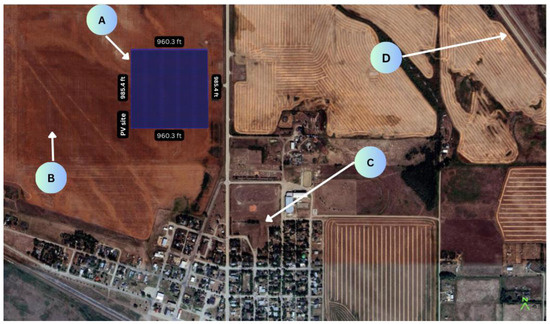
Figure 1.
Potential site for PV and wind turbine Installation.
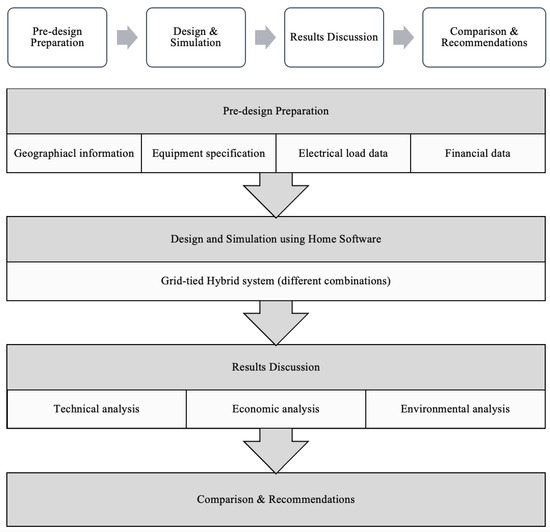
Figure 2.
Homer Pro simulation flowchart.
The solar energy potential in Alberta is among the highest in Canada, ranking second in the nation. It is estimated that Alberta has the capacity to produce 1276 kilowatt-hours per kilowatt of solar PV (fixed axis) output annually (Energy Hub 2023) [19]. In this regard, a solar irradiance and wind potential map of the considered location can be seen in Figure 3 and Figure 4, respectively.
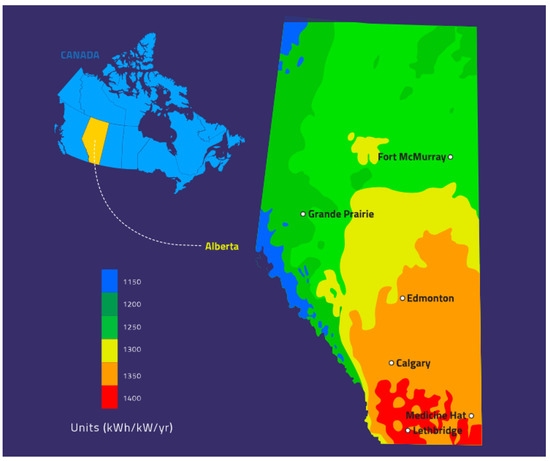
Figure 3.
Solar potential map of southern Alberta.
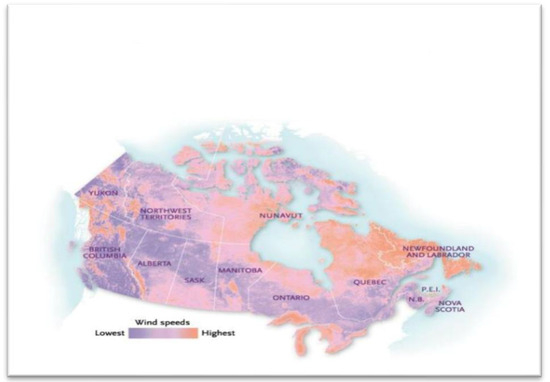
Figure 4.
Wind potential map of southern Alberta.
2.2. Load Profile
To design the hybrid renewable system, it is crucial to estimate the energy demand of the residential houses. Siksika Nation has a population of approximately 7800 and around 1000 houses [20,21]. On average, a typical house in Canada consumes 37.5 kWh per day [22]. The load profile shown is modelled to meet the energy demands of more than 1000 houses and small-scale industries in Siksika Nation and the community beside it, Gleichen, Alberta. The peak load is modelled to be around 5.4 MW, and the average energy utilized would be 44.8 MWh/day. The load factor of this system is 0.35 as shown in Table 2. The load factor is defined as the average load divided by the peak load in a specific period and ranges from 0–1. A higher load factor indicates a well-designed system.

Table 2.
AC load parameters of Gleichen, Alberta.
2.3. Wind Speed Data
Southern Alberta is mainly grassland, with strong wind throughout the year. Gleichen’s wind speed data were collected from the NASA Prediction of Worldwide Energy Sources [23]. The annual average wind speed was found to be 5.90 m/s at a height of 50 m above the surface of the earth. Moreover, monthly average wind speed data can be seen in Figure 5. The latitude and the longitude of the location were used to find the relevant data in the NASA database.
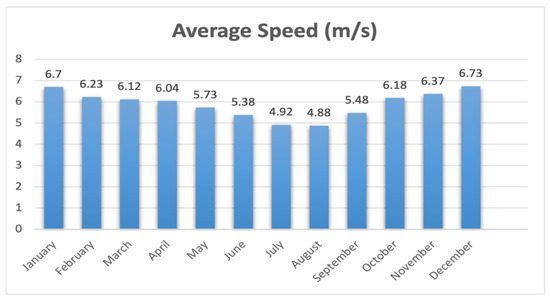
Figure 5.
Monthly average wind speed in Gleichen, Alberta.
2.4. Solar GHI Data
Typical locations in Alberta have more than 2500 hours of sun yearly, exceeding most other regions in Canada. The daily radiation and clearness index data were obtained from NASA’s Prediction of Worldwide Energy Sources [23]. The annual average radiation is 3.57 kWh/m2/day. The clearness index is highest in July and lowest in January. The monthly average solar GHI in Gleichen, Alberta is shown in Figure 6.
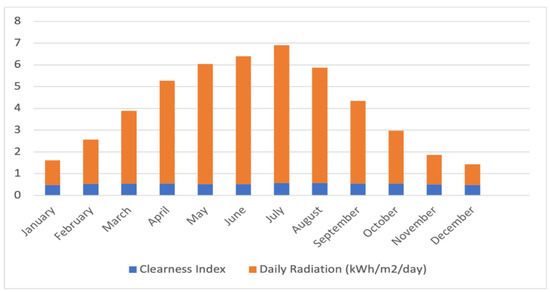
Figure 6.
Monthly average solar global horizontal irradiance (GHI) in Gleichen, Alberta.
3. Mathematical Modeling
3.1. Solar Photovoltaic System
The Osterwald method is the most used equation to show the output power of the PV calculated by the following equation (Osterwald 1986) [24]:
where Ppv is the PV’s generated power, N is the number of solar PV modules, Am is the area of the module, is the generator’s efficiency, and Gt is the global radiation on the tilted plane (W/m2).
3.2. Wind Turbine System
The estimation of wind power can be made using the following equation:
where P is the power generated by the wind turbine (kW), v is the wind speed in m/s, ρ is the density of the air in kg/m3, and A is the cross-sectional area of the wind in m2.
3.3. Performance Factors for Techno-Economic Analysis
In the evaluation of the techno-economic feasibility for a system designed to maximize the use of renewable resources (high renewable fraction), key performance indicators, including economic metrics like LCOE and NPC, along with considerations for GHG emissions, are taken into account to ensure an optimal design.
3.3.1. Net Present Cost
The current total of all the expenditures incurred by the hybrid system during its specified useful life, minus the salvage value over that useful life, is its net present cost. The costs listed in the equation that are included in the net present cost are capital, replacement, operating, and maintenance costs. The provided system’s component NPCs are calculated using Equation (3) through the HOMER Pro software, where Ccapital denotes the initial investment, Creplaces denotes the cost of replacement, Cmaintain denotes the cost of upkeep, and Csalvage denotes the cost of salvage [10].
3.3.2. Levelized Cost of Energy
The levelized cost of electricity is the average cost per kilowatt-hour of electrical energy produced by a specific system. LCOE is determined by division of the total annualized cost by the sum of LprimeAC and LprimeDC using the equation below in HOMER [10].
- LprimeAC = Alternating current primary load.
- LprimeDC = Direct current main load.
3.3.3. Total Annualized Cost
It is described as the value that will occur annually over the course of the project’s expected timeframe and is expected to provide the NPC connected to the component cash flow order. Using HOMER Pro software (Version 3.1.2) USA, the capital recovery factor is multiplied after the entire annualized cost has been determined using NPC [10].
3.4. System Strategy
3.4.1. National Grid Configuration
In grid-connected systems as shown in Figure 7, the grid is used as a backup power source or as a means to sell unused power. It also serves to distribute power when the renewable energy source is insufficient, for example, when there is no sunlight during nighttime to meet the load demand, and it draws power when there is a surplus. When operating off-grid, the system is supported by battery energy storage. As shown in Table 3, the energy price was taken as an average from different electricity providers in Gleichen, Alberta, which include transmission and distribution charges at CAD 0.127 per kWh and the grid buying price of CAD 0.065 per kWh [25]. The grid is capable of providing a maximum peak load upto 2500 kW to ensure the maximum contribution from BESS.
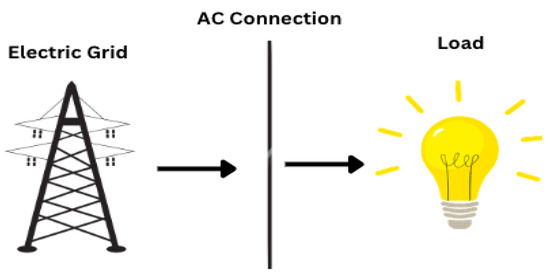
Figure 7.
Schematic presentation of grid and AC load (base case).

Table 3.
Energy providers and their rates in Gleichen, Alberta (energy rates 2023) [25].
3.4.2. Grid-Tied PV System
In this configuration, the power generation system mainly relies on the PV system to supply clean energy, as shown in Figure 8. HOMER optimized the need for the 9500-kW system with a BESS capacity of 2500 kWh. The renewable fraction of the system configuration was 24.1%.
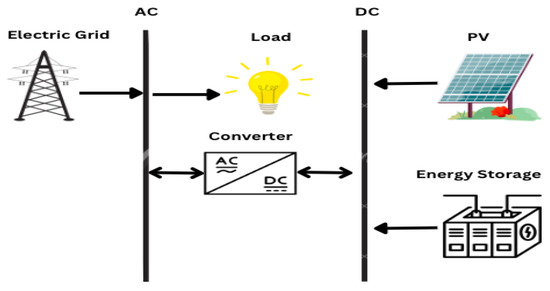
Figure 8.
Schematic presentation of grid-connected PV system.
3.4.3. Grid-Tied WT System
In this configuration, the power generation system mainly relies on the wind turbines (WT) system to supply clean energy, as shown in Figure 9. HOMER software optimized the need for 6000 kW of the WT system with a battery capacity of 2500 kWh. The renewable fraction of the system configuration was 79.6%.
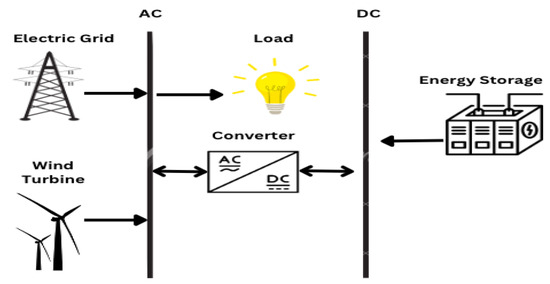
Figure 9.
Schematic presentation of grid-connected wind turbine system.
3.4.4. Grid-Tied PV-WT System
In this configuration, power generation system optimization was carried out on a combination of both PV and wind turbine systems to supply clean energy, as shown in Figure 10. HOMER optimized the need for 6264 kW of the PV system and 4500 kW of the wind turbine system with a BESS capacity of 2500 kWh. The renewable fraction of the system configuration was 80%.
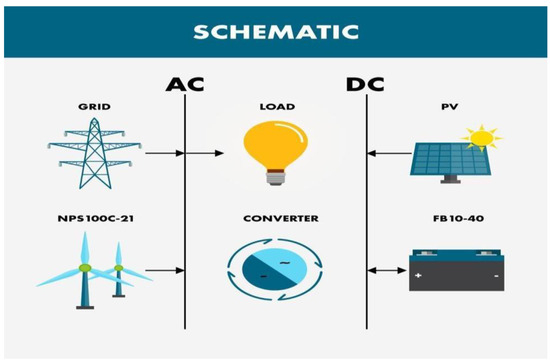
Figure 10.
Schematic presentation of grid-connected PV and wind turbine system.
4. Results and Discussion
4.1. Techno-Economic Analysis and Comparison of System Configurations
Various renewable-based hybrid configurations are compared with the base configuration (utility grid with battery backup) to evaluate the economic viability, cost-effectiveness, and environmental soundness of retaining lower initial costs and other system parameters. The economic analysis and GHG emissions, considering all system configurations, are presented in Table 4.

Table 4.
Simulation results of considered configurations of power systems.
The transformation to renewable energy has become an economic need rather than only an environmental one. As shown in Table 4, the LCOE of hybrid systems is less than the conventional National Grid system. However, in PV-Grid configuration, LCOE is comparatively higher than others as the renewable penetration in the configuration is quite low, i.e., 24.1% in comparison to 79.6% and 80% of WT-Grid and PV-WT-Grid, respectively. In the case of major reliance on the solar installation, the initial capital costs would increase exponentially. The distribution of CAPEX and OPEX differs from one system to another. The CAPEX includes capital and replacement costs, while the OPEX includes maintenance and fuel costs. Figure 11 presents a comparison between the system configurations of maintenance, capital, and replacement costs.
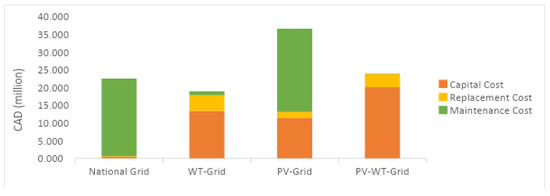
Figure 11.
Cost analysis of different power system configurations.
The capital cost includes the cost of equipment such as solar PV panels, wind turbines, converters, and ESS, which usually incurs costs at the beginning of the project life cycle. Since solar PV panels and wind turbines are not required in the national grid configuration, the capital cost is less than the cost of renewable energy-based systems. In hybrid systems that include renewable energy, the capital cost is mainly dependent on the capacity of the renewable system.
From a capital cost (CAPEX) perspective, the national grid utilization might seem attractive compared with hybrid systems. However, it costs much more than OPEX, reducing its value as a power supply option. On the other hand, the systems comprising solar and wind turbine systems are attractive in terms of OPEX, but the high initial costs of renewables result in high CAPEX. Generally, the hybrid system seems the most appropriate option to economically supply the industrial and commercial loads in either stand-alone or grid-integrated mode. Moreover, renewable systems have longer operational lives, typically with a payback period that makes the overall renewable sources-based systems more economical. The payback period of the optimized grid-tied PV-WT hybrid system is almost 9.7 years compared to the grid-tied WT system’s 6.18 years due to the higher capital costs. Moreover, the cash flow for each of the configurations can be seen in Figure 12, Figure 13, Figure 14 and Figure 15.
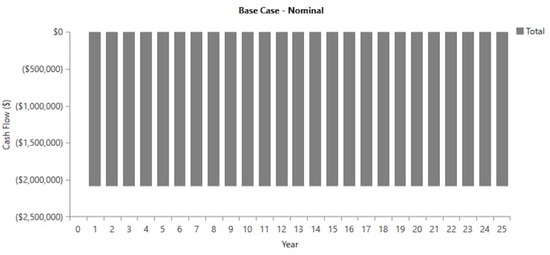
Figure 12.
Cash flow of national grid-only system configuration.
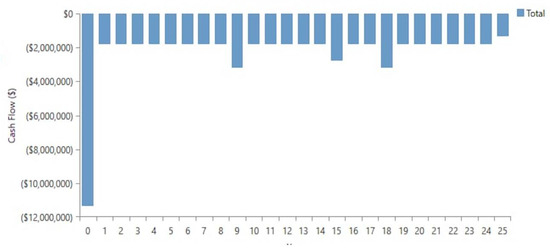
Figure 13.
Cash flow of PV–grid system configuration.
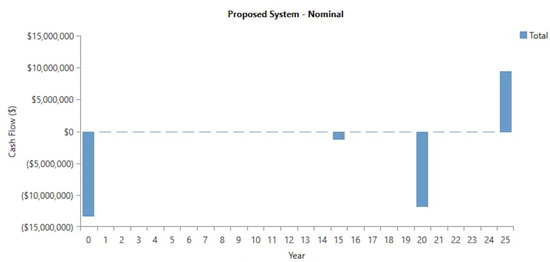
Figure 14.
Cash flow of WT–grid system configuration.
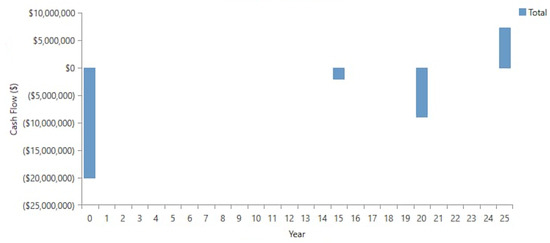
Figure 15.
Cash flow of grid-tied PV-WT system configuration.
As can be seen in the above figures, cash flow represents the costs associated with the considered power system in terms of expenses or income. Regarding storage and modulation, the number of batteries utilized for backup systems can be seen in Figure 16.
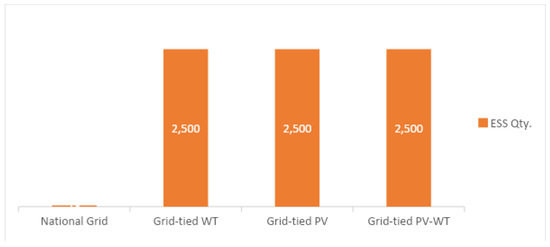
Figure 16.
ESS quantity for different power system configurations.
It should be kept in mind that the battery backup size was calculated while keeping in view the storage autonomy, that is, the ratio of storage bank size to electric load. The BESS autonomy was set to the 1.07 h to create the same simulation environment for all considered hybrid combinations in order to achieve the most optimal system. Regarding the payback period, grid-tied WT-BESS-based hybrid power systems showed the shortest payback period of 6.18 years, and the grid-tied PV-WT hybrid system showed payback of 9.7 years compared to 9.21 years for grid-tied PV configurations due to the higher prices of photovoltaic and wind turbine systems, which ultimately lead to increases in overall cost and payback period.
It can be seen in Figure 16 that the battery backup for the hybrid renewables configuration was kept constant to consider the technoeconomic analysis in similar situations. Likewise, as shown in Figure 17, the optimized system emits greenhouse gases of up to 3,199,882 kg/year compared to the 8,719,564 kg/year of the National Grid only setup for the same load capacity. The optimized system shows significant reductions in environmental pollution.
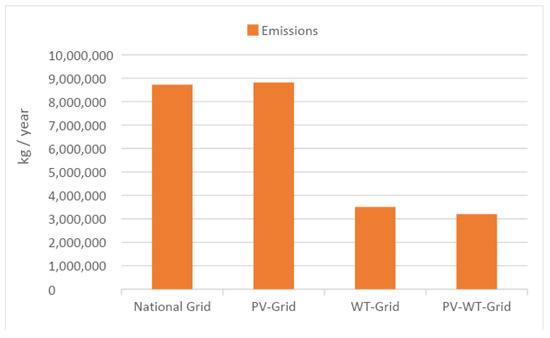
Figure 17.
GHG emissions for different power system configurations.
As shown in Table 5, the LCOE ranges from 0.0412 CAD/kWh to 0.127 CAD/kWh, from which the proposed optimized hybrid system comprising a grid-tied PV-WT configuration exhibits an LCOE of 0.0705. The environmental impact is reduced in the proposed hybrid configuration because the renewable fraction is improved.

Table 5.
Simulation results of the considered configurations of power systems.
The simulation results indicate that the proposed grid-tied PV-WT-based hybrid system has an LCOE value of 0.0705 CAD/kWh while having a comparatively higher capital investment compared to other combinations of hybrid systems due to the inclusion of renewable sources. Moreover, the renewable fraction of the most optimized hybrid system (PV-WT-Grid) is 80%. The simulated results presented above indicate that the proposed hybrid system configuration for the load, under the current economic and emission performance, can be considered as the optimal solution.
4.2. Sensitivity Analysis
Various system variables have distinct impacts on the system’s performance. Through sensitivity analysis, the study evaluates how the proposed system performs under different conditions, particularly focusing on battery type and grid unit price variations. Technoeconomic comparison is carried out by using lead–acid and lithium-ion batteries to analyze the system’s performance. As can be seen in Table 5, lithium-ion energy storage systems (ESS) are competitive with lead–acid types in terms of levelized cost of energy (LCOE), replacement costs, and maintenance costs. Additionally, the system requires fewer lithium-ion batteries to meet the exact requirements, leading to an improved renewable fraction. The capacity and performance of the ESS are enhanced with lithium-ion batteries compared to lead–acid ones, further boosting the renewable fraction. Moreover, lithium-ion batteries are more environmentally friendly, with approximately 20–25% lower greenhouse gas (GHG) emissions compared to lead–acid batteries. However, the capital cost of the system increases when replacing lead–acid with lithium-ion batteries, primarily due to the higher unit price of lithium-ion batteries [26]. But their longer lives decrease the overall system costs.
Similarly, as illustrated in Table 6, fluctuations in fuel prices have a significant effect on the performance of the overall system. Even though the unit prices from utility grids have increased substantially, the impact of hybridization with renewables has reduced the overall unit costs, along with a major portion of generation through renewable resources that ultimately led to a reduction in greenhouse gas emissions. The presented sensitivity analysis proves the importance and authenticates the feasibility of the proposed renewable-based hybrid configuration from a future perspective as well.

Table 6.
Simulation results of system configurations with current electricity unit prices and future forecast prices.
4.3. Comparative Studies
In the proposed research work, the real-time load profile of the Siksika Nation community near Gleichen is considered in order to design and optimize a renewable resources-based hybrid power generation method for environmentally friendly and economical electrification. A comparative study of the proposed configuration is carried out with the designed system available in literature and can be seen in Table 7. No case study similar to the proposed study has been found in literature with respect to daily load consumption. However, the comparison is carried out to highlight the importance of a renewable fraction in compensating for the load demand. The comparative study shows the significance of the tri-bed system in achieving energy with low COE and GHG emissions. However, most of the studies previously conducted have utilized diesel generators as secondary backup sources before the grid, which increases the overall GHG emissions.

Table 7.
Comparative study with the previous studies.
5. Conclusions
The proposed study demonstrates that transitioning to renewable energy technologies is necessary in order to gain reliable, clean electricity for residential, commercial, or industrial loads, especially with the energy demand associated with industrial and technological expansion. A hybrid grid-connected system consisting of PV–wind–battery is proposed in this research work to compensate for the actual load demand, and it resulted in a cost reduction of approximately 56% in the overall system. The renewable fraction of the hybrid system is almost 80%, indicating that the proposed system is more environmentally friendly while having a very low LCOE of 0.0705 CAD/kWh. The study results show that intelligent systems must be implemented for energy management to enable the transformation to renewable energy and to develop a green energy sector.
In keeping with the Green Initiative vision across the globe, the conversion of conventional fuel-based power systems over the efficient tri-brid energy system configuration proposed in this study would have substantial benefits. Integration of the tri-brid system with the grid to sell excess energy generation and the analysis of revenue generation make this approach more cost-effective and reliable.
Next, various other viable renewable sources could be considered to increase the reliance on renewables and decrease the overall costs. Furthermore, adaptation of the latest technology for battery backup systems can increase the overall efficiency of the system.
Author Contributions
M.A.A. planned and conducted the main investigation, drafted the manuscript, and prepared the tables and figures. Every author contributed equally to making this study into a productive and valuable research work. All authors have read and agreed to the published version of the manuscript.
Funding
This research work was funded by MITACS, Old Sun Community College, and the partner organization Siksika SRDL Group. The reference number for the grants is IT28955.
Informed Consent Statement
Not Applicable.
Data Availability Statement
The data in the paper belong to the funding organization and authors and are not for public use. They can be made available upon request.
Conflicts of Interest
The authors declare no conflicts of interest.
References
- Nikzad, R.; Sedigh, G. Greenhouse Gas Emissions and Green Technologies in Canada. Environ. Dev. 2017, 24, 99–108. [Google Scholar] [CrossRef]
- Hosseini, S.M.; Kanagaraj, N.; Sadeghi, S.; Yousefi, H. Midpoint and Endpoint Impacts of Electricity Generation by Renewable and Nonrenewable Technologies: A Case Study of Alberta, Canada. Renew. Energy 2022, 197, 22–39. [Google Scholar] [CrossRef]
- Hastings-Simon, S.; Leach, A.; Shaffer, B.; Weis, T. Alberta’s Renewable Electricity Program: Design, Results, and Lessons Learned. Energy Policy 2022, 171, 113266. [Google Scholar] [CrossRef]
- Jamil, U.; Pearce, J.M. Energy Policy for Agrivoltaics in Alberta Canada. Energies 2023, 16, 53. [Google Scholar] [CrossRef]
- Martins Godinho, C.; Noble, B.; Poelzer, G.; Hanna, K. Impact Assessment for Renewable Energy Development: Analysis of Impacts and Mitigation Practices for Wind Energy in Western Canada. Impact Assess. Proj. Apprais. 2023, 41, 59–70. [Google Scholar] [CrossRef]
- Bensalah, A.; Barakat, G.; Amara, Y. Electrical Generators for Large Wind Turbine: Trends and Challenges. Energies 2022, 15, 6700. [Google Scholar] [CrossRef]
- Priyanka, T.J.; Atre, S.; Billal, M.M.; Arani, M. Techno-Economic Analysis of a Renewable-Based Hybrid Energy System for Utility and Transportation Facilities in a Remote Community of Northern Alberta. Clean. Energy Syst. 2023, 6, 100073. [Google Scholar] [CrossRef]
- Robertson, B.; Bekker, J.; Buckham, B. Renewable Integration for Remote Communities: Comparative Allowable Cost Analyses for Hydro, Solar and Wave Energy. Appl. Energy 2020, 264, 114677. [Google Scholar] [CrossRef]
- Environment and Climate Change Canada. Greenhouse Gas Emissions. Available online: https://www.canada.ca/en/environment-climate-change/services/environmental-indicators/greenhouse-gas-emissions.html (accessed on 14 March 2024).
- Ur Rashid, M.; Ullah, I.; Mehran, M.; Baharom, M.N.R.; Khan, F. Techno-Economic Analysis of Grid-Connected Hybrid Renewable Energy System for Remote Areas Electrification Using Homer Pro. J. Electr. Eng. Technol. 2022, 17, 981–997. [Google Scholar] [CrossRef]
- Li, C.; Zhou, D.; Zheng, Y. Techno-Economic Comparative Study of Grid-Connected PV Power Systems in Five Climate Zones, China. Energy 2018, 165, 1352–1369. [Google Scholar] [CrossRef]
- Kapoor, S.; Sharma, A.K. Techno-Economic Analysis by Homer-pro Approach of Solar on-Grid System for Fatehpur-Village, India. J. Phys. Conf. Ser. 2021, 2070, 012146. [Google Scholar] [CrossRef]
- Das, B.K.; Alotaibi, M.A.; Das, P.; Islam, M.S.; Das, S.K.; Hossain, M.A. Feasibility and Techno-Economic Analysis of Stand-Alone and Grid-Connected PV/Wind/Diesel/Batt Hybrid Energy System: A Case Study. Energy Strategy Rev. 2021, 37, 100673. [Google Scholar] [CrossRef]
- Abdin, Z.; Mérida, W. Hybrid Energy Systems for Off-Grid Power Supply and Hydrogen Production Based on Renewable Energy: A Techno-Economic Analysis. Energy Convers. Manag. 2019, 196, 1068–1079. [Google Scholar] [CrossRef]
- Longo, M.; Yaïci, W.; Foiadelli, F. Hybrid Renewable Energy System with Storage for Electrification—Case Study of Remote Northern Community in Canada. Int. J. Smart Grid 2019, 3, 63–72. [Google Scholar]
- Performance Analysis of a Photovoltaic/Wind/Diesel Hybrid Power Generation System for Domestic Utilization in Winnipeg, Manitoba, Canada–Arabzadeh Saheli–2019–Environmental Progress & Sustainable Energy–Wiley Online Library. Available online: https://aiche.onlinelibrary.wiley.com/doi/10.1002/ep.12939 (accessed on 14 March 2024).
- Kaluthanthrige, R.; Rajapakse, A.D.; Lamothe, C.; Mosallat, F. Optimal Sizing and Performance Evaluation of a Hybrid Renewable Energy System for an Off-Grid Power System in Northern Canada. Technol. Econ. Smart Grids Sustain. Energy 2019, 4, 4. [Google Scholar] [CrossRef]
- How HOMER Calculates Wind Turbine Power Output. Available online: https://homerenergy.com/products/pro/docs/3.15/how_homer_calculates_wind_turbine_power_output.html (accessed on 14 March 2024).
- Urban, R. Solar Power Alberta (2023 Guide). Available online: https://www.energyhub.org/alberta/ (accessed on 14 March 2024).
- Siksika Nation. Available online: https://siksikanation.com/ (accessed on 14 March 2024).
- Government of Canada Statistics. Census Profile, 2021 Census of Population. Available online: https://www12.statcan.gc.ca/census-recensement/2021/dp-pd/prof/index.cfm?Lang=E (accessed on 14 March 2024).
- How Many kWh Does the Average Home Use? Available online: https://ca.renogy.com/blog/how-many-kwh-does-the-average-home-use/ (accessed on 14 March 2024).
- NASA POWER | Prediction of Worldwide Energy Resources. Available online: https://power.larc.nasa.gov/ (accessed on 14 March 2024).
- Osterwald, C.R. Translation of Device Performance Measurements to Reference Conditions. Sol. Cells 1986, 18, 269–279. [Google Scholar] [CrossRef]
- Select Alberta Electricity Provider. Available online: https://energyrates.ca/select-alberta-electricity-provider/ (accessed on 14 March 2024).
- Yousef, B.A.A.; Amjad, R.; Alajmi, N.A.; Rezk, H. Feasibility of integrated photovoltaic and mechanical storage systems for irrigation purposes in remote areas: Optimization, energy management, and multicriteria decision-making. Case Stud. Therm. Eng. 2022, 38, 102363. [Google Scholar] [CrossRef]
- Kayode, T.A.; Daniel, R.E.E. Economic and environmental analysis of a grid-connected hybrid power system for a University Campus. Bull. Natl. Res. Cent. 2023, 47, 75. [Google Scholar]
- Alya, A.; Nasser, A.S.; Ameena, S.A.S.; Mousa, M.; Tareefa, A.; Ehsan, H.F. Techno-Economic Analysis of Hybrid Renewable Energy Systems Designed for Electric Vehicle Charging: A Case Study from the United Arab Emirates. Energies 2022, 15, 18. [Google Scholar] [CrossRef]
Disclaimer/Publisher’s Note: The statements, opinions and data contained in all publications are solely those of the individual author(s) and contributor(s) and not of MDPI and/or the editor(s). MDPI and/or the editor(s) disclaim responsibility for any injury to people or property resulting from any ideas, methods, instructions or products referred to in the content. |
© 2024 by the authors. Licensee MDPI, Basel, Switzerland. This article is an open access article distributed under the terms and conditions of the Creative Commons Attribution (CC BY) license (https://creativecommons.org/licenses/by/4.0/).